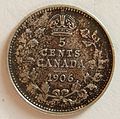Top Qs
Timeline
Chat
Perspective
Nickel (Canadian coin)
Canadian coin worth 5 cents From Wikipedia, the free encyclopedia
Remove ads
The Canadian five-cent coin, commonly called a nickel, is a coin worth five cents or one-twentieth of a Canadian dollar. It was patterned on the corresponding coin in the neighbouring United States. It became the smallest-valued coin in the currency upon the discontinuation of the penny in 2013.
Remove ads
History
Summarize
Perspective
This section needs additional citations for verification. (February 2025) |
The "Victory nickel", struck from 1943 to 1945, was the first non-standard circulating Canadian coin other than commemorative dollars; the reverse features a flaming torch and a large V that stands for both Victory and the coin's denomination. The rim denticles were replaced by the phrase "We win when we work willingly" in Morse Code. This design was re-used in 2005 to commemorate the 60th anniversary of V-E Day. Almost uniquely in the history of Canadian coinage, the reverse was engraved to scale by Thomas Shingles; most coin designs are engraved at a much larger scale and reduced with a pantograph.
In 1951, a special commemorative five-cent piece depicting a nickel refinery was struck to celebrate the 200th anniversary of the metal's initial discovery by Swedish chemist Axel F. Cronstedt. Due to the onset of the Korean War, production of this commemorative was halted to preserve nickel for the war effort, resulting in a second non-commemorative 1951 "nickel" made of plated steel.
In 1967, all the circulating coins received a special reverse for the Canadian Centennial; the nickel featured a rabbit.
In proof sets issued since 1996, the five cent coin is made of sterling silver. Some commemorative five cent coins are also made of sterling silver.
Remove ads
Types and specifications
Remove ads
Circulation figures
Victoria & Edward VII
George V & George VI



Elizabeth II


This section needs additional citations for verification. (August 2024) |
Charles III
Remove ads
Commemoratives
Remove ads
Collecting
According to author Allen G. Berman, Canadian nickels struck in pure nickel are "very difficult to grade" due to the alloy's hardness.[10] Five-cent coins dated 1921 are among the rarest and most collectible Canadian circulation coins, known as "the Prince of Canadian Coins." Estimates of the number of specimens known range between 400 and 480. In May 1921, the government of Canada passed an act authorizing the change to the larger nickel coin, and subsequently the majority of the 1921 mint run was melted down.[11] The coin believed to be the finest-known specimen (PCGS MS-67) sold for US$115,000 at auction in January 2010.[12] It was then sold by the Canadian Numismatic Company for $160,000 to a private collector in early 2012.
Remove ads
See also
- Big Nickel
- Dei Gratia Regina (or Rex), which appears abbreviated on the face of the coin.
Notes
Remove ads
References
External links
Wikiwand - on
Seamless Wikipedia browsing. On steroids.
Remove ads



















